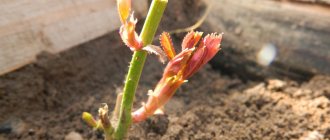Description of the variety with photographs
A photo and description of the Rosemary variety can give some idea of the characteristics of this violet, but every flower lover will be literally enchanted by seeing this delicate flower in person.
The author of the variety is breeder E. Lebetskaya. Large, about 6 centimeters in diameter, Rosemary violet flowers are shaped like lush pompoms. The flower petals of this variety are double, with wavy edges. The color of the flowers is white with pink streaks and blue specks. This combination of three colors against the background of dark green on top and reddish on the inside, wavy, jagged foliage looks quite unusual. Many gardeners note that the color of flowers can change depending on the air temperature. In the summer heat, the white color from the petals practically disappears, and the flowers become deep pink with purple streaks.
The plant forms a large, up to 32 centimeters in diameter, lush rosette. Rosemary's flower stalks are short. Fluffy bouquets of flowers are located exactly in the center of the leaf rosette, and large, wavy leaves frame it along the edge.
Features of the variety
Fascinating tricolor violet: description and photo
Le Rosemary is a violet that blooms with extraordinary pom-pom flowers. Their diameter can be up to 6 centimeters. In addition, there are at least 2-3 of them on one peduncle. The flowers themselves are quite dense and terry. The edges of their petals are wavy. This is not just a violet violet. The petals may have a variety of patterns: small spots, strokes, dots. Each flower has its own personality. This makes the plant quite extraordinary. Peduncles are very short. Thanks to this, the bouquets are formed in the center of the rosette itself.
Le Rosemary is a violet who is afraid of lack of light. In such situations, its rosette is formed incorrectly: the ground part is greatly extended. As for the foliage, it has a jagged edge. At the same time, its color is dark green, and from the inside it is reddish.
It is worth noting that this variety easily reproduces and produces children. It is extremely rare to find flowers that are pure blue or blue with a white border.
Reproduction
Climbing rose “Rococo”: description of the variety, photos, reviews
Violet "LE-Rosemary", like other varieties, can be propagated by seeds or cuttings. Plant leaves are used as the latter. The seed method is considered more complex, so experts recommend using the leaf rooting method. First of all, a healthy, strong leaf of rather large size, growing on a short stalk, is cut off from the mother violet. An elongated cutting will not work in this case, since it most often does not produce children.
The sheet is cut at an angle of 45 degrees with a sharp and pre-processed tool. Next, it is placed in a glass filled with drainage and soil mixture. The diameter of the container should be approximately 5-6 centimeters. It is better to take a ready-made substrate and further enrich it with a small amount of superphosphate and wood ash. The leaf goes deep into the soil to a depth of 2 to 10 centimeters. Next, you will have to spray the soil with a spray bottle and cover it with a transparent plastic cap.
Having transplanted a young plant into an already permanent pot, it is worth preparing for some common problems that arise with LE-Rosemary. If the violet does not bloom, then the problem is most likely due to insufficient lighting. Ideally, daylight hours for Saintpaulia are 12 hours. Another likely cause may be that the pot size is too large. When the leaves darken and fall off, we are talking about some kind of exposure to cold, for example, contact with an icy window or watering with cold water and then getting on the leaves. Another similar effect occurs when the leaves are exposed to direct sunlight.
Curling edges occur when violets are grown in too acidic soil. The only correct solution would be to transplant her immediately. A yellow “frill” or completely yellowed leaves indicate a lack of useful elements. Too high a temperature and low air humidity will cause the buds to stop opening completely, but will begin to dry out quickly. A similar effect occurs when planted in a substrate with high acidity.
Dry air along with excess sun leads to the fact that the leaves begin to hang unsightly from the pot. If holes or plaque appear on the leaves, and the petioles begin to rot, then most likely the violet is sick or has been attacked by pests. Since the cause of most diseases is improper care, it must be adjusted immediately. In general, it is better to free a diseased plant from damaged particles and replant it in a new pot with fresh substrate. Additionally, the crop is treated with a fungicide.
You can watch a video review of the LE-Rosemary violet of an unusual color below.
Basic signs and superstitions
The Irish rose blooms for only 3 months (from July to September). But if it is possible to create 16-hour lighting, then the flower will be able to survive in winter.
Popular colors are:
Summer residents adore Lisianthus for its bright and contrasting color, which can be combined to create a design. It resembles a rose due to its shape and large bud. And its petals can be double or ordinary.
Lisianthus is a finicky plant and therefore you need to be careful about its location when growing it.
The plant loves fresh air, so it should be planted in a well-ventilated, but at the same time quite warm place. At home, you need to create shady conditions if the plant is on a windowsill, because in direct sunlight the flower can get burned. In summer it is recommended to take it out onto the balcony.
Features of the variety
Description and characteristics of the “wild rose” tomato variety with photos
Le Rosemary is a violet that blooms with extraordinary pom-pom flowers. Their diameter can be up to 6 centimeters. In addition, there are at least 2-3 of them on one peduncle. The flowers themselves are quite dense and terry. The edges of their petals are wavy. This is not just a violet violet. The petals may have a variety of patterns: small spots, strokes, dots. Each flower has its own personality. This makes the plant quite extraordinary. Peduncles are very short. Thanks to this, the bouquets are formed in the center of the rosette itself.
Le Rosemary is a violet who is afraid of lack of light. In such situations, its rosette is formed incorrectly: the ground part is greatly extended. As for the foliage, it has a jagged edge. At the same time, its color is dark green, and from the inside it is reddish.
It is worth noting that this variety easily reproduces and produces children. It is extremely rare to find flowers that are pure blue or blue with a white border.
Basic signs and superstitions
The Irish rose blooms for only 3 months (from July to September). But if it is possible to create 16-hour lighting, then the flower will be able to survive in winter.
Popular colors are:
Summer residents adore Lisianthus for its bright and contrasting color, which can be combined to create a design. It resembles a rose due to its shape and large bud. And its petals can be double or ordinary.
Lisianthus is a finicky plant and therefore you need to be careful about its location when growing it.
The plant loves fresh air, so it should be planted in a well-ventilated, but at the same time quite warm place. At home, you need to create shady conditions if the plant is on a windowsill, because in direct sunlight the flower can get burned. In summer it is recommended to take it out onto the balcony.
Voir aussi[modifier]
| Rivaux et | Pseudo-rivaux | ||
| Kanto | Blue•Trace | Johto | Luth/Célesta |
| Johto | Silver | Sinnoh | Louka/Aurore |
| Hoenn | Brice / Flora • Timmy | ||
| Sinnoh | Barry | ||
| Unys | Bianca • Tcheren • Matis | ||
| Kalos | Serena / Kalem • Sannah • Tierno • Trovato | ||
| Alola | Tili • Gladio | ||
| Galar | Nabil • Travis • Rosemary •Sophora / Saturnin |
| Champions d'Arènes | ||
Transfer
The violet variety "LE-Rosemary" does not require large pots. On the contrary, excess free space can slow down the flowering process. Ideally, the container in which the flower will be placed should have a diameter half the size of the rosette itself and have a sufficient number of drainage holes at the bottom. The most preferred material is plastic. As soon as the soil is almost completely filled with roots, it is time to expect flower stalks to appear.
If you purchase a violet that is already blooming, then it is not necessary to replant it immediately. At a minimum, you should wait until the roots begin to protrude from the holes in the bottom. In addition, an indication for the movement of flowers is the poor condition of the soil: it either no longer contains nutrients, or has been subjected to excessive watering, which has led to rotting of the root system. The same applies to the appearance of a white coating on the ground - it is created due to an excess of mineral fertilizers.
Violets can be replanted at any time of the year, with the exception of those periods when buds are being laid. It is also recommended to avoid the winter months, since at this time the flower is at its weakest, and it should not create additional stress. Fresh soil should be nutritious and also loose. You can purchase a ready-made mixture in the store, or you can create it yourself from part river sand, five parts deciduous soil and three parts peat. Before use, it would be good to bake the soil in the oven for a couple of hours.
Before starting the actual transplantation of “LE-Rosemary”, in the new pot you will have to organize a layer of drainage from two-centimeter pieces of bricks, small stones and pebbles. The soil mixture is placed on top, so as to reach the middle of the height of the container. Additionally, you can enrich the soil with a tablespoon of superphosphate and a tablespoon of wood ash. The Saintpaulia is carefully removed from the pot and placed in the middle of the new one.
Everything is sprinkled with earth, and there should be about a centimeter between the edge of the pot and the soil level. The violet is irrigated and immediately installed in a well-lit, warm place.
The main components of caring for Saintpaulia "LE-Rosemary" are watering, fertilizing and pruning. Violet does not require form pruning, but it still needs to remove faded buds, dried or otherwise damaged leaves. If you want to update the rosette, you can cut it off completely, leaving only a stump under the lower leaves. If you place the rosette in water, the violet will soon sprout new roots.
Watering
Irrigation of Saintpaulia is carried out 2-3 times a week. The amount of water should be moderate, otherwise it is easy to provoke rotting of the root system and, as a result, the death of the entire plant. The temperature of the water used should be maintained between 20 and 22 degrees Celsius. It needs to settle well, and, if possible, also filter. The use of melted liquid is considered no less successful.
Watering itself can be either top or bottom. When watering from above, the liquid flows gently along the edge of the pot
It is very important to avoid getting moisture on the leaves and stems, but you need to evenly saturate the soil throughout the entire container. Bottom watering involves pouring water exclusively into the tray of the pot.
Thus, the roots have the opportunity to consume as much moisture as necessary.
Top dressing
Fertilizers are applied throughout the year. At the beginning of winter, before flowering begins, it is recommended to purchase compositions with nitrogen, for example, “Master Color”. At the moment when the violet begins to form buds, you can use combinations with potassium and phosphorus - they will contribute to long and beautiful flowering. Suitable in this case are drugs such as Kemira Lux, which are applied every couple of weeks. Some experts are of the opinion that complex preparations can be applied to the soil every week, but by reducing the dosage by half.
Saintpaulia "LE-Rosemary" responds well to foliar feeding through regular spraying. True, in this case it is necessary to take into account that there cannot be any drafts or exposure to direct ultraviolet radiation. The dosage for spraying should be two times weaker than for root feeding.
Stone mountain rose: planting
You should not overdo it with watering, otherwise the echeveria will begin to increase in size and lose its beautiful color. Among other things, as it grows it loses its frost-resistant properties and can die in the cold. It needs to be fertilized approximately once every 3-4 years, when the soil does not have enough vitamin properties. In the absence of fertilizers, it feeds on the organic matter of neighboring plants, feeding itself and its offspring.
This rose is usually planted (propagated) during the months:
It must be taken into account that the plant needs to get used to it and it is better to do the last planting before the first frost. You can plant echeveria in a flowerbed even when it was in a home pot. It's very easy to do.
You just need to take a flower with a lump of earth and drag it into the prepared hole.
If the earthen lump has crumbled and the roots are just sticking out, you need to take a flower with roots, plant it in the hole, the roots need to be pressed well into the ground and covered with earth. It must be remembered that it is better to keep the distance between flowers 10-15 cm so that they can grow and reproduce freely.
Violet Ice Rose: cultivation and care
Violet Ice Rose: photo
The violet variety Ice Rose does not take special care of itself. In order for the violet to perform decorative functions, it is necessary to correctly select the volume of the pot, as well as the soil mixture, and create the necessary parameters of heat, light and humidity.
Thus, the soil must be rich, fertile and at the same time loose enough so that air can circulate freely in it. It is optimal to use ready-made soil for violets, which contains all the necessary components.
The container for the violet PC Ice Rose must be suitable and match the size of the bush, since an excessively large volume of the pot will contribute to the development of a large number of plant roots, while very few flowers will ripen. While the small volume of the pot will not allow you to grow a large root system, so the plant will begin to bloom faster.
Lighting for violets of the Ice Rose variety will be optimal in summer and spring-summer, when daylight hours are long enough. In the winter months, it will be necessary to create artificial lighting, for which an excellent option would be the use of fluorescent lamps. You should also be careful when growing violets on a southern windowsill, as the scorching rays of the sun can leave a burn on the leaves of the plant.
In addition, the optimal temperature for growing violets of the Ice Rose variety will be approximately 20 degrees, despite its cold name. If you keep the RS Ice Rose violet at a given temperature, it will thank you with abundant and beautiful flowering.
The humidity for the Ice Rose violet should be medium. The ideal option would be a level of 50%. In winter, when heating devices are operating, it is better to increase the humidity level artificially using small containers filled with water. You can also install a humidifier.
Plant propagation
The violet variety Ice Rose is propagated using cuttings, which are placed either immediately in prepared soil or first in water. If you place the cuttings in a glass of water, you will need to use a small amount of moisture and be patient as this method takes longer. However, it is precisely this that is most favorable for better rooting of the plant.
Most often, gardeners propagate the PC Ice Rose violet using a leaf, which is cut with a sharp, disinfected knife at an angle. A healthy leaf plate is selected as planting material. Next, the leaves are placed in soil or water.
Watering
In order for the violet of the Ice Rose variety to look impressive and not have any problems when growing it, you should follow simple care rules. Water for irrigation should be warm, about 20-25 degrees and pre-settled. If you water the plant with cold water, the roots may rot. When watering, it is better not to get it on the leaves and flowers, since the villi retain moisture, which can lead to the formation of fungal diseases.
Replanting and pruning
Also, an adult Ice Rose violet needs to be replanted annually into a larger container. Transplantation is carried out using the transshipment method, preserving the earthen ball of the root system as completely as possible. In adult plants, the lower part of the leaves is removed, the upper rosette is cut off and also rooted using a container of water, since old bushes look ugly.
Feeding
Like any indoor flowering plant, the Ice Rose violet needs fertilizer, which can be started six months after planting, since all the necessary nutrients are provided during planting. Ice roses are fed with nitrogen-containing preparations in the spring and during the period of active growth of stems and leaves. During flowering of plants, potassium-containing preparations are used. The fertilizer regime should be approximately 2 times every 14 days. In this case, it is necessary to use the solution according to the instructions indicated on it.
If the violet variety RS Ice Rose does not bloom, this may indicate a deficiency of phosphorus in the soil, so you can use feeding with a phosphorus-containing preparation. Experienced gardeners do not advise feeding violets immediately after transplantation, when there is a sudden change in temperature in the room, or when the bush grows on the south side of the apartment.
What the violet and marble rose love
Prairie gentian is finicky and prefers different temperatures at different times of the year. In summer - the temperature should not exceed 25 ᵒС and should not be lower than 20 ᵒС. In autumn and winter – not lower than 12 ᵒС and not higher than 15 ᵒС.
Eustoma loves light, so you need to try to ensure that the flower that is at home receives a sufficient amount of it. But the main thing is not to overdo it, otherwise it will burn.
The plant has a sensitive root system. Therefore, you need to be very careful about the content of salts, acids and alkalis in the soil. For indoor plants, you can use soil that is easy to find in the store.
Land is selected with the required amount:
- Minerals;
- Microelements;
- Peat;
- Sand.
A prerequisite must be that the pot is roomy and spacious in width and there are large holes at the bottom. When caring for Lisianthus, you need to ensure that they are pruned correctly to form a crown and additional cuttings. Eustoma loves a lot of water, so it has to be watered often. Unlike other plants, it should be watered already when the top of the post becomes dry. For watering, you need to use water that has had time to settle, because the plant is susceptible to various impurities. The flower requires care, so after watering, the water is poured out of the pan so that the roots do not rot. Be sure to ensure that moisture does not get on the leaves, this can develop fungal diseases on them. To prevent the flower from getting sick, leave the leaves dry.
During growth and flowering, especially in the spring and summer, the Mountain Rose needs to be fed. It is better to take fertilizers that contain potassium and phosphorus. These are the components she needs most. The violet got its name from its clear marbled pattern. They look like large beautiful semi-double and double flowers. These flowers are similar to a rose with a pale pink color. Equal amounts of red and white.
Violet "Lituanica"
The violet was bred by a breeder from Vilnius - Butene Fatina Kiryanovna. From Latin “Lituanica” is translated as “Lithuania”. In the minds of Lithuanians, this name is associated with two Lithuanian pilots who crashed over New York in 1933. On that fateful day, they were flying on a bright orange plane called the Lituanica. Many believe that Boutene named the violet after them.
'Lituanica' has dark green, jagged foliage. The leaves are not large at all; they are located on long thin stems.
The inflorescences of "Lituanica" are not at all similar to the standard violet. They are more reminiscent of a tea rose, rosehip or dahlia. "Lituanica" has an unusual flower shape. Basically, the flowers are soft pink or peach in color, sometimes you can notice a brighter petal frame.
This is a very complex and whimsical variety. Breeding "Lituanica" is a real feat, because violet requires a lot of attention. This variety loves only natural light; its favorite place to grow is the windowsill. You should not forget about watering, because violets do not tolerate drying out.
Conditions for care and maintenance of the Rosemary variety
Rosemary violet is demanding on growing conditions. This applies to watering, air temperature, lighting and even the growing container. The flowering of this variety will depend on proper care.
Temperature and lighting
Like all purple violets, Rosemary does not tolerate exposure to direct sunlight. But she also doesn’t like the lack of lighting. Therefore, the plant must be kept in a place where diffused light enters during the day. Western or eastern windows are ideal in this regard.
In winter, on cloudy, short days, additional artificial lighting must be installed above the plant. Increasing daylight hours has a positive effect on violet flowering. It can bloom almost all year round, with a short break in winter.
With insufficient lighting, Rosemary violet raises its leaves, and the flowers lose their colorful attractiveness. If such signs appear, the plant needs to be moved to a brighter place.
Rosemary violets are grown only in warm rooms.
Rosemary violet is heat-loving, and keeping it in a cool room will cause root rot and negatively affect the flowering of the variety. In autumn and spring, when it is cool enough on the windowsill, it is better to move the flower away from the window onto shelves or special stands.
The optimal temperature for violets is 20-22 degrees. Significant deviations in one direction or another can lead to plant diseases. The main enemy of violets is temperature changes. In such conditions, the plant begins to hurt and stops flowering.
Watering and fertilizing
Optimal soil moisture when growing violets is one of the important conditions for its proper growth. The violet should be watered moderately, no more than 2 times a week, with warm, settled or melt water.
Rosemary violets are watered using the top and bottom method:
- When watering from above, water is poured into the edge of the pot, without getting on the leaves or in the center. When watering, you need to ensure that the soil evenly absorbs moisture over the entire diameter of the pot.
- When bottom watering, water is poured into a tray in which the pot is placed. This type of watering is more correct, since the soil is moistened evenly and water does not get to the point of growth of the rosette.
Violet needs to be fed throughout the year. Before flowering, nitrogen fertilizer is used to grow leaves. When buds begin to form, nitrogen should be excluded from fertilizing. During this period, phosphorus-potassium mixtures are used, which have a beneficial effect on flowering processes. Fertilizing is carried out weekly with special fertilizers.
Violet Rosemary: cultivation and care
Violet Rosemary: photo
Before planting Rosemary violet, you need to prepare the place, as well as set the correct lighting, temperature and humidity. All these criteria must be taken into account, otherwise the plant will not be able to take root and will die. Rosemary violet is a variety that loves light, so there should be a lot of light. The only thing that needs to be taken into account is that direct rays have a detrimental effect on the plant, so the violet variety LE Rosemary must be protected from them. If the plant is exposed to direct rays, then burns will appear on the violet, which will develop into ulcers and it will be impossible to cure them. Usually in this case the plant dies. Therefore, the best place for the plant will be a western or eastern location, this is where the diffused light is located. With the onset of winter, lighting becomes less, so you need to start using lamps that will serve as light. On average, a plant needs 12 hours of light.
Temperature is also an important criterion when growing LE Rosemary violets. It should be within 21-22 degrees, while the air humidity should be no more than 58%. If the temperature is below the limit, then the process of rotting in the root system will begin, this process will spread to the entire plant and this will lead to a bad outcome. If the temperature is higher, the surface of the flower will be dry, limp and the plant will look sick. Experienced gardeners recommend moving the plant at the beginning of autumn; it is usually moved to a warmer place in the room.
Note: I would like to note that temperature changes will have terrible consequences on the LE Rosemary violet, so it is recommended to keep the temperature within normal limits. The consequences will be the cessation of flowering and death.
How to replant violet variety LE Rosemary?
LE Rosemary violet should be grown in the correct size pots. They should not be large, since in such a container the development of the root system, as well as the process of bud formation and flowering itself, is inhibited. In the best case, the pot will be two sizes smaller than its rosettes. In this case, there should be holes at the bottom of the pot that will serve as small drainage. After completely filling the space in the pot, the plant begins the process of forming buds, after which flower stalks and buds begin to appear.
Note: If the Rosemary violet was purchased in a store or nursery already in bloom, then replanting should be postponed until a later time.
The plant should only be replanted in well-prepared soil. Before transplanting, it must be fertilized with complex fertilizer or wood ash. After applying fertilizer, you need to loosen the soil well so that it becomes light and conducts oxygen without obstacles. Very often, gardeners buy ready-made nutrient soil, in which everything is added in the correct proportions.
You can replant the plant at any season; this will not affect the plant in any way if the temperature and air humidity are maintained.
Before planting, it is necessary to lay a drainage system consisting of broken bricks, pebbles or expanded clay at the bottom of the hill. Then nutritious soil is placed and the plant is planted in a pot. If you want the plant to quickly enter the active growth stage, then add a little phosphate or nitrogen fertilizer to the soil. They have a good effect on the growth and development of the plant.
Watering.
Care is one of the most important criteria after planting the LE Rosemary violet. In no case should we forget about it, since it is an integral part of the whole process. Be sure to water the plant, apply fertilizer, and also prune. Usually, sanitary pruning will be enough for the violet, which consists of simply getting rid of various dry and weak leaves or parts of the plant.
Watering comes first in importance.
Reproduction
Violets are propagated by leaf cuttings - this is the most common method, because in most cases it gives good results.
For successful rooting you need:
- select a large healthy leaf on an adult plant;
- carefully cut it at an angle with a sharp garden knife;
- the cut cuttings are planted in special soil or placed in water.
If you decide to buy a plant for propagation, pay attention to the quality of the cuttings
The sheet should be:
- strong, without signs of fading;
- without spots on the leaf blade and petiole;
- the petiole should not be very elongated.
To plant the cuttings, prepare small (5cm) pots or small plastic cups; do not forget to make holes in the bottom. ¼ of the container is filled with drainage composition. This can be expanded clay that has undergone additional heat treatment or polystyrene foam balls mixed with soil. When rooting a leaf in the ground, it is advisable to purchase a specially prepared soil mixture for violets in the store or prepare it yourself by mixing 5 parts of soil, 3 parts of peat, 1 part sand, add a little wood ash and superphosphate fertilizer.
Shelves for violets
Marshmallow
“Where did the passion for violets begin? When did the first flower appear at home? — I asked Galina. And I heard an interesting story - how an ordinary gift turned into more than just a flower hobby. He became a part of Galina’s soul and life.
In 2000, a relative Irina gave Galina a violet for her birthday. This violet became the first drop in the ocean of Galina Leontyeva’s violet passion.
New items brought from the exhibition Grown-up Antares and Whipped Cream
“I started visiting flower exhibitions and sales, where you can buy rare violets,” says Galina, “and always returned home with a cutting—a leaf of a new variety, or a sprout of a violet, or a new adult violet.”
Violet became for Galina a new song of the soul, a new step into tomorrow. But it also required a lot of care. The first question became: where to place the pots of violets? How to provide all plants with light? It’s good when there are three violets on the windowsill, they have enough space and light from the window. What if there are 300 varieties of violets? Yes, each variety has children growing up, then how? This is where the regiments came to Galina’s aid.
Yes, ordinary shelves, but for the violets they turned into a multi-story home. From standard furniture shelves you can assemble racks of various modules, which can be conveniently placed next to the window sill, above the chest of drawers, and along the wall of the room. And definitely with lighting! Fluorescent lamps will enable plants to successfully develop and grow. And, of course, delight your mistress with the first flowering, responding with blossoming living beauty to your care for them.
For me, violets always evoke positive emotions, lift my spirits and make me feel like spring is approaching. And Galina admits: “Violet for me is a hormone of JOY!” So let there be more such joys in our lives!
Other articles about fresh flowers and those who put their love into them: Summer in the park. Lawn Magnolias. Summer in the park. Garden of Roses. Report from spring. Country Tulip. “My pride is Tulips!”. Violet fairy tale.
8 votes Average rating: 4.9 out of 5
How to care?
Proper watering is very important for “Maria”. Experts recommend watering a houseplant no more than 2 times a week. Two methods of watering are suitable: top and bottom. The first is characterized by filling the violet pot with water “to the brim”, but the leaves are not properly moistened. The bottom method involves filling the pot tray with water.
The liquid for irrigation should be warm. It is not recommended to water violets with ice water. Air humidity in the room is not lower than 50%. You can periodically carefully spray the plant with a spray bottle. During the flowering period, violets need fertilizing with mineral fertilizers (at least 2 times a week).
Stone mountain rose: planting
You should not overdo it with watering, otherwise the echeveria will begin to increase in size and lose its beautiful color. Among other things, as it grows it loses its frost-resistant properties and can die in the cold. It needs to be fertilized approximately once every 3-4 years, when the soil does not have enough vitamin properties. In the absence of fertilizers, it feeds on the organic matter of neighboring plants, feeding itself and its offspring.
This rose is usually planted (propagated) during the months:
It must be taken into account that the plant needs to get used to it and it is better to do the last planting before the first frost. You can plant echeveria in a flowerbed even when it was in a home pot. It's very easy to do.
You just need to take a flower with a lump of earth and drag it into the prepared hole.
If the earthen lump has crumbled and the roots are just sticking out, you need to take a flower with roots, plant it in the hole, the roots need to be pressed well into the ground and covered with earth. It must be remembered that it is better to keep the distance between flowers 10-15 cm so that they can grow and reproduce freely.
Magnificent violet Marble rose (S. Farbitnik)
Each plant is unique, and often even varieties of the same species are very different from each other.
When buying a new individual, it is important to know:
- How to properly care for her;
- What will she look like when she grows up?
- And what surprises it can present to the owner.
Most Saintpaulias are similar to each other, but an individual approach to each of them guarantees an excellent result. In the article you will see a photo and description of Saintpaulia Marble Rose.
Violet Marble Rose (S. Farbitnik)
Fascinating violet Marble rose.
Marble rose is a violet of Usambor, genus Saintpaulia hybrid, family Gesneriev, class dicotyledonous, division flowering. The variety was bred by Sofia Farbitnik.
The rosette is standard size, about 25-28 cm in diameter. Sheets:
- Very dark, green shade;
- Glossy;
- Round with a heart-shaped base.
Flowering is abundant, but gradual. There are usually a lot of flower stalks, and there are also buds on them, but before the next flower opens, the previous one begins to fade.
The color is fancy, the flowers are double and semi-double. The main tone is white and pink with a crimson-red marble pattern.
The size of the flowers is large, up to 7 cm, but the more abundant the flowering, the smaller they are.
The variety is resistant to difficult conditions, and even in the heat it blooms successfully, producing 2-3 peduncles with a bunch of buds. The variety is not slow to grow, but the young plant requires attention.
Attention! The first flowering is usually sparse and reaches its maximum bloom at least by the third time.
Caring for a plant at home
In matters of care, the Marble Rose is not demanding. Flowering responds to certain maintenance parameters by changing the size and color of flowers.
For good flowering, the variety requires proper care.
Transplantation, pruning, rejuvenation
Young plants are regularly replanted; as they grow, they are usually simply transferred to a larger pot. Adult Saintpaulias are usually replanted once a year, with a complete replacement of the soil.
Saintpaulias need to be replanted once a year.
When replanting adult flowers, they are usually pruned and rejuvenated. First of all, remove the old ones:
- Leaves;
- Peduncles;
- And roots.
Leaves and peduncles are trimmed as needed, regardless of transplantation. If the rosette has aged or the stem has become very long, it is cut off by removing the lower part. If roots remain on the rosette, it is simply replanted, and if pruning occurs high, then the top is first rooted.
Planting and care
Echeveria is an indoor plant that does not need a lot of space; sunlight will be enough for it. To create a beautiful composition, you can use a wide pot made of stone, clay or a florarium. A florarium is a floral arrangement or flower that is placed behind glass (glass, aquarium, jar, decanter, etc.).
The flower has many names:
- The blossoming was young;
- Echeveria;
- Echeveria;
- Stone Flower;
- Hare cabbage;
- Living tiles;
- Always a living stone;
- Hen with chicks.
But the most popular name is stone rose. Echeveria has different shapes and colors. It belongs to the genus succulent and the Crassulaceae family. A stone rose may have a waxy coating or fluff that helps the plant hide from the sun's rays and protect itself from the winter cold.
It’s not enough to plant a stone rose; you need to know how to properly care for it. To do this, you need to feed it periodically.
The stone rose was first discovered in Mexico, where the weather is bright and sunny. It is unpretentious and can exist even in arid areas. But in weather below 0 ᵒC the plant may die.
A brief overview of the most spectacular and beautiful violets
Based on the usual blue-flowered classic violet, breeders have developed a huge number of new varieties, differing in a variety of color shades and shapes.
Breeders have bred about 500 varieties of violets
All Saintpaulias are divided into groups:
- Collectible. Exclusive exhibition whimsical plants with lush large flowers (up to 5–7 cm in diameter) of a variety of colors.
- Variegated. They are distinguished by their bright and unusual coloring of the leaf plates.
- Industrial. Simple, undemanding violets, grown using special technologies in large quantities, are used for interior decoration.
Currently, several hundred varieties and hybrids of Saintpaulia are cultivated. It is quite possible to highlight the most spectacular and unusual ones:
- Winter rose. A plant with small pubescent dark green leaves and strongly double, rose-like inflorescences of a rich violet-blue color with a thin snow-white border.
- Currant dessert. A common and popular variety with semi-double star inflorescences of rich purple color. The petals are slightly pointed and surrounded at the edges by a thin wavy border of a darker shade, reminiscent of currant jam.
- Chimera. A mutant violet resulting from a random mutation and crossing of two species. You can recognize a chimera by the presence of a radial stripe of a contrasting color on each petal. Striped flowers can come in a variety of colors. Sometimes there are leaf chimeras that have stripes on the leaves.
- The bride's bouquet. The plant is shaped like a wedding bouquet. Above a rosette of large glossy dark green leaves are large snow-white star-shaped inflorescences (without colored inclusions) with wavy petals.
- Snow lace. Lush and long-blooming violet with simple light green leaves. The inflorescences are huge, double, with corrugated snow-white petals with blurry bluish splashes in the middle and a greenish edging.
- Georgia. A variety with large double flowers of rich pink color with a lilac-violet coating of small specks. Delicate wide wavy petals are decorated with a thin corrugated edging along the edge, the color of which varies from yellow-golden to light green.
- Marquise. A spectacular and unusual flower with a flat and even rosette of shiny quilted dark green, slightly pubescent leaves, blooming profusely in large (more than 6 cm) double inflorescences of bright pink color. The flowers near the center are highlighted a little darker, the petals have a dark lilac velvety border and a thin white line along the very edge.
- Magdalene. A popular variety with bright pink openwork inflorescences-balls, composed of a large number of delicate wavy petals. There are many peduncles, they are densely located, which makes the flower look like a bouquet.
- A gift for a loved one. A plant with unusual pointed rich green leaves, outlined by a wide creamy-pink border along the edges. The flowers are a deep dark blue with a purplish-red ruffled edge.
- Villodene. Quite a large flower, the diameter of the rosette can reach 40–45 cm. The main advantage of this violet is the beautiful, very wavy, variegated emerald green leaves, covered with pinkish and white spots. The peach-pink flowers are simple, with a wavy greenish edging along the edge of the petals.
- Amadeus. A flower with a loose large rosette (up to 40 cm in diameter) of large burdock-shaped, medium-green leaves. Huge (up to 8 cm) double bright red-crimson flowers with a whitened center and a heavily ruffled elegant white border.
- Rosemary. A most exquisite plant with large (5–6 cm) double pom-pom flowers of three colors. Delicate velvety coral-pink petals with wavy white edges are decorated with bright blue patterns (dots, strokes, small spots). The leaves are serrated and dark green.
I have been working with violets for several years and have collected a collection of more than 20 varieties. Although the plants are not very whimsical for the most part, they require quite frequent replanting, since the rosettes grow quickly. If this is not done on time, the flowers lose their decorative effect and look sloppy. I had to give it to my friends and neighbors because I didn’t have enough time.
Rules of care
Every gardener, and just ordinary gardeners, love to decorate their flower beds with beautiful, special and unusual plants.
Kinds:
- Lisianthus;
- Eustoma;
- Prairie gentian;
- Texas Bluebell;
- Irish rose.
Lisianthus is a wonderful choice for any summer resident or gardener if he wants bright, variegated flowers with an eccentric arrangement of spots to grow in his flowerbed. Eustoma is a 70 cm tall flower that grows in meadows and fields.
It has strong stems that have many branches, and the leaves are long, round in shape, and bluish-green in color.
This flower is native to America and Mexico. But, at home, this flower grows no more than 50 cm. In general, eustoma is considered an annual plant, but experienced gardeners who know a lot about their business manage to create such comfortable conditions that the flower grows the next year.
Methods and methods of propagation of the variety
Violet reproduces by rooting leaves. To obtain a new plant from the mother specimen, it is necessary to cut a large, healthy leaf on a short cutting. The cuttings are cut with a sharp knife or blade at an angle of 45 degrees.
For rooting, the cut cuttings are planted in a pot or glass with a diameter of 5-6 centimeters. There should be a hole at the bottom of the cup, and a drainage layer (expanded clay, pieces of foam plastic, fine gravel) should be placed on the bottom. To fill the glass, it is advisable to purchase special soil. You can prepare the substrate yourself from garden soil (5 parts), peat (3 parts), sand (1 part) and add a pinch of wood ash and a little superphosphate to it.
The cut sheet is placed at an angle in the prepared soil, deepened by 1-15 centimeters. Deeper planting is not recommended, as the cuttings will begin to rot. The soil in the pot is moistened with a spray bottle and the leaf is covered with a transparent cap. Rooting is carried out in a warm, bright place.
Rosemary violet can be propagated by rooting a leaf.











